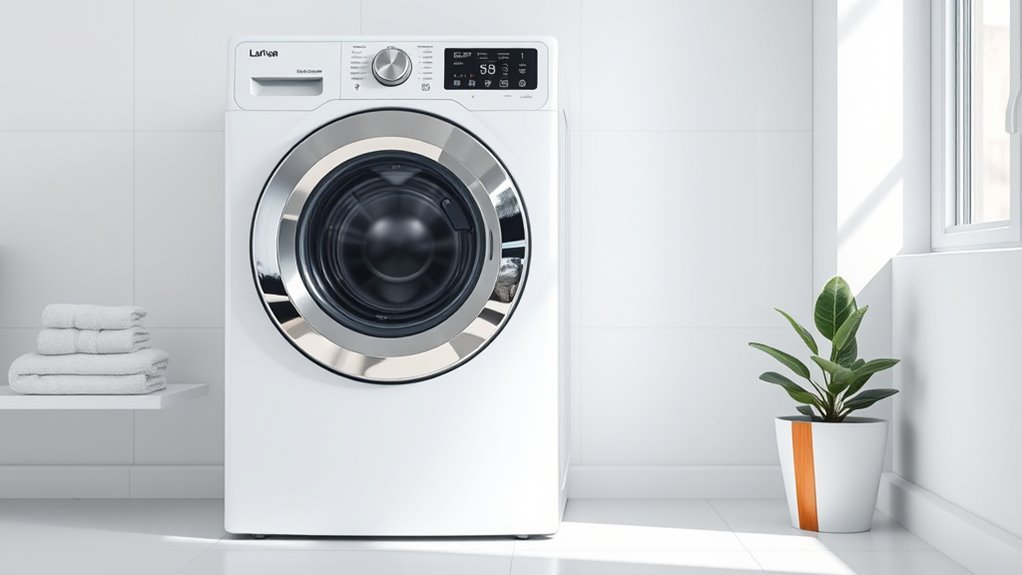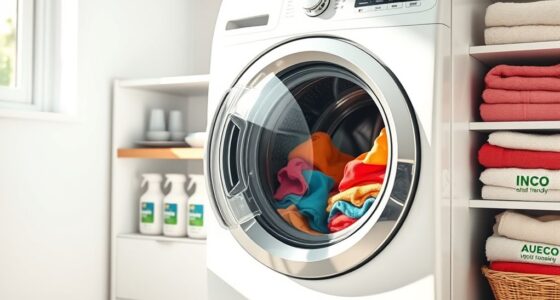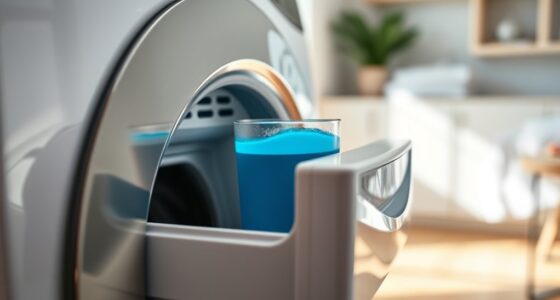Combined washer-dryer units save space and are perfect for small homes or apartments, as they eliminate the need for separate machines and venting. They are energy-efficient, using advanced technology to conserve water and electricity, which helps lower utility bills. However, their smaller capacity means longer drying times and limited laundry volume, making them less suitable for large families. While convenient and easy to install, maintenance can be tricky. To discover more about how they fit your lifestyle, keep exploring their features.
Key Takeaways
- Space-saving design integrates washing and drying in one appliance, ideal for small homes and apartments.
- Energy-efficient features reduce utility bills by optimizing water and electricity use.
- Limited capacity may not meet high laundry demands, and drying can be less effective in humid environments.
- Easy installation with minimal hookups, suitable for locations without external venting.
- Maintenance can be more complex due to combined functions and potential for higher noise levels during operation.

If space is limited in your home, combined washer-dryer units offer an efficient solution. These all-in-one appliances are designed to conserve space, making them ideal for apartments, small homes, or laundry closets where maximizing every square foot matters. One of their key advantages is their energy efficiency. Modern combined units are built with advanced technology that optimizes water and electricity use, helping you reduce utility bills and minimize your environmental impact. With features like sensor-driven wash cycles and heat pump drying, these machines can adapt to load size and fabric type, ensuring you use only what’s necessary. This not only conserves resources but also extends the lifespan of your clothing. Additionally, installation flexibility is a significant perk. Unlike traditional separate washer and dryer pairs, which require more space and complex hookups, combined units are self-contained and easier to install. You typically only need a single electrical outlet and a water connection, simplifying setup and reducing installation costs. This flexibility allows you to place the unit in more varied locations within your home, whether it’s a tight laundry closet or a corner of your bathroom. Because they don’t require venting like traditional dryers, they can be installed in places where venting isn’t feasible, such as apartments or rooms without external walls. Moreover, many models are designed with user convenience in mind, featuring intuitive controls and quick wash or dry cycles that save time. However, while the space-saving benefits and installation flexibility are clear advantages, there are some trade-offs to weigh. For instance, combined units often have smaller capacities compared to separate machines, which can be inconvenient if you have large families or generate lots of laundry. The drying cycle might also take longer or be less effective than a dedicated dryer, especially in humid environments. Maintenance can be more challenging too, since you’re dealing with a single unit for both washing and drying, meaning any repair issues affect both functions simultaneously. Additionally, because these machines are compact, they might generate more noise during operation than larger, standalone units. Overall, if your priority is saving space and you value energy efficiency and installation flexibility, combined washer-dryer units can be a smart choice. Just weigh their capacity limitations and potential maintenance concerns to ensure they fit your laundry needs. They’re especially practical for those who want a streamlined, space-conscious laundry solution without sacrificing modern features and efficiency.
Frequently Asked Questions
How Energy Efficient Are Combined Washer-Dryer Units Compared to Separate Appliances?
Combined washer-dryer units tend to be less energy efficient than separate appliances because they often use more energy for their dual functions. However, if you choose models with eco-friendly features and energy-saving settings, you can reduce energy consumption. While they save space and convenience, keep in mind that their efficiency varies, so look for those with good energy ratings to make the most eco-friendly choice.
What Is the Typical Lifespan of a Combined Washer-Dryer Unit?
You might think your combo unit lasts forever, but typical lifespan is about 8-12 years. Ironically, maintenance challenges and high replacement costs often cut that short. You’ll probably face more repairs compared to separate appliances, and when it finally quits, it’s costly to replace. So, while it seems durable, expect to budget for repairs or replacements sooner rather than later. Stay prepared for the inevitable!
Can Combined Units Handle Large Loads Effectively?
Combined units can handle large loads, but their load capacity is usually lower than separate appliances. You might find that they struggle with very bulky items or heavy laundry, especially if you’re doing multiple loads at once. Spin performance can also vary, so check the specs to guarantee it effectively removes excess water. Overall, for large loads, a dedicated washer and dryer might be more reliable.
Are There Specific Brands Known for Durability in Washer-Dryer Combos?
Did you know that LG and Samsung are often rated highest for durability in washer-dryer combos? These brands are known for their strong reliability and advanced durability factors, making them popular choices. You can count on LG’s innovative technology and Samsung’s robust build quality to last longer. If you want a machine that stands the test of time, focusing on these brands increases your chances of getting a durable, dependable unit.
How Easy Is It to Repair or Maintain Combined Washer-Dryer Units?
Repair complexity for combined washer-dryer units varies; some models are straightforward to maintain, while others can be tricky. You’ll find that maintenance requirements are generally moderate, but you may need to clear lint filters or check hoses regularly. If a major issue arises, repairs might be more involved than standalone machines, so it’s wise to choose a reliable brand and keep up with routine upkeep to prevent costly fixes.
Conclusion
So, whether you’re tempted by the convenience or cautious of the cons, weigh your needs carefully. While combined washer-dryer units offer a compact, cost-effective, and clutter-clearing solution, they can also compromise on capacity and cycle speed. Decide what’s most important — efficiency, ease, or endurance — and make your choice confidently. Remember, weighing the wins and woes will help you weave a washer-dryer wonder that works perfectly for your space and style.








